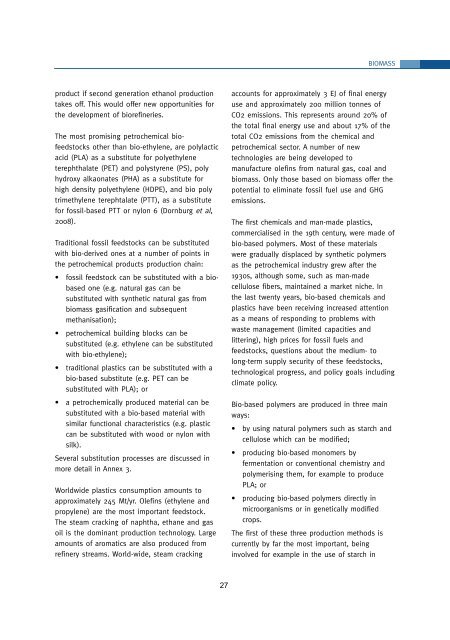Renewable Energy in Industrial Applications â an ... - Unido
Renewable Energy in Industrial Applications â an ... - Unido
Renewable Energy in Industrial Applications â an ... - Unido
You also want an ePaper? Increase the reach of your titles
YUMPU automatically turns print PDFs into web optimized ePapers that Google loves.
BIOMASS<br />
product if second generation eth<strong>an</strong>ol production<br />
takes off. This would offer new opportunities for<br />
the development of bioref<strong>in</strong>eries.<br />
The most promis<strong>in</strong>g petrochemical biofeedstocks<br />
other th<strong>an</strong> bio-ethylene, are polylactic<br />
acid (PLA) as a substitute for polyethylene<br />
terephthalate (PET) <strong>an</strong>d polystyrene (PS), poly<br />
hydroxy alkaonates (PHA) as a substitute for<br />
high density polyethylene (HDPE), <strong>an</strong>d bio poly<br />
trimethylene terephtalate (PTT), as a substitute<br />
for fossil-based PTT or nylon 6 (Dornburg et al,<br />
2008).<br />
Traditional fossil feedstocks c<strong>an</strong> be substituted<br />
with bio-derived ones at a number of po<strong>in</strong>ts <strong>in</strong><br />
the petrochemical products production cha<strong>in</strong>:<br />
• fossil feedstock c<strong>an</strong> be substituted with a biobased<br />
one (e.g. natural gas c<strong>an</strong> be<br />
substituted with synthetic natural gas from<br />
biomass gasification <strong>an</strong>d subsequent<br />
meth<strong>an</strong>isation);<br />
• petrochemical build<strong>in</strong>g blocks c<strong>an</strong> be<br />
substituted (e.g. ethylene c<strong>an</strong> be substituted<br />
with bio-ethylene);<br />
• traditional plastics c<strong>an</strong> be substituted with a<br />
bio-based substitute (e.g. PET c<strong>an</strong> be<br />
substituted with PLA); or<br />
• a petrochemically produced material c<strong>an</strong> be<br />
substituted with a bio-based material with<br />
similar functional characteristics (e.g. plastic<br />
c<strong>an</strong> be substituted with wood or nylon with<br />
silk).<br />
Several substitution processes are discussed <strong>in</strong><br />
more detail <strong>in</strong> Annex 3.<br />
Worldwide plastics consumption amounts to<br />
approximately 245 Mt/yr. Olef<strong>in</strong>s (ethylene <strong>an</strong>d<br />
propylene) are the most import<strong>an</strong>t feedstock.<br />
The steam crack<strong>in</strong>g of naphtha, eth<strong>an</strong>e <strong>an</strong>d gas<br />
oil is the dom<strong>in</strong><strong>an</strong>t production technology. Large<br />
amounts of aromatics are also produced from<br />
ref<strong>in</strong>ery streams. World-wide, steam crack<strong>in</strong>g<br />
accounts for approximately 3 EJ of f<strong>in</strong>al energy<br />
use <strong>an</strong>d approximately 200 million tonnes of<br />
CO2 emissions. This represents around 20% of<br />
the total f<strong>in</strong>al energy use <strong>an</strong>d about 17% of the<br />
total CO2 emissions from the chemical <strong>an</strong>d<br />
petrochemical sector. A number of new<br />
technologies are be<strong>in</strong>g developed to<br />
m<strong>an</strong>ufacture olef<strong>in</strong>s from natural gas, coal <strong>an</strong>d<br />
biomass. Only those based on biomass offer the<br />
potential to elim<strong>in</strong>ate fossil fuel use <strong>an</strong>d GHG<br />
emissions.<br />
The first chemicals <strong>an</strong>d m<strong>an</strong>-made plastics,<br />
commercialised <strong>in</strong> the 19th century, were made of<br />
bio-based polymers. Most of these materials<br />
were gradually displaced by synthetic polymers<br />
as the petrochemical <strong>in</strong>dustry grew after the<br />
1930s, although some, such as m<strong>an</strong>-made<br />
cellulose fibers, ma<strong>in</strong>ta<strong>in</strong>ed a market niche. In<br />
the last twenty years, bio-based chemicals <strong>an</strong>d<br />
plastics have been receiv<strong>in</strong>g <strong>in</strong>creased attention<br />
as a me<strong>an</strong>s of respond<strong>in</strong>g to problems with<br />
waste m<strong>an</strong>agement (limited capacities <strong>an</strong>d<br />
litter<strong>in</strong>g), high prices for fossil fuels <strong>an</strong>d<br />
feedstocks, questions about the medium- to<br />
long-term supply security of these feedstocks,<br />
technological progress, <strong>an</strong>d policy goals <strong>in</strong>clud<strong>in</strong>g<br />
climate policy.<br />
Bio-based polymers are produced <strong>in</strong> three ma<strong>in</strong><br />
ways:<br />
• by us<strong>in</strong>g natural polymers such as starch <strong>an</strong>d<br />
cellulose which c<strong>an</strong> be modified;<br />
• produc<strong>in</strong>g bio-based monomers by<br />
fermentation or conventional chemistry <strong>an</strong>d<br />
polymeris<strong>in</strong>g them, for example to produce<br />
PLA; or<br />
• produc<strong>in</strong>g bio-based polymers directly <strong>in</strong><br />
microorg<strong>an</strong>isms or <strong>in</strong> genetically modified<br />
crops.<br />
The first of these three production methods is<br />
currently by far the most import<strong>an</strong>t, be<strong>in</strong>g<br />
<strong>in</strong>volved for example <strong>in</strong> the use of starch <strong>in</strong><br />
27

















